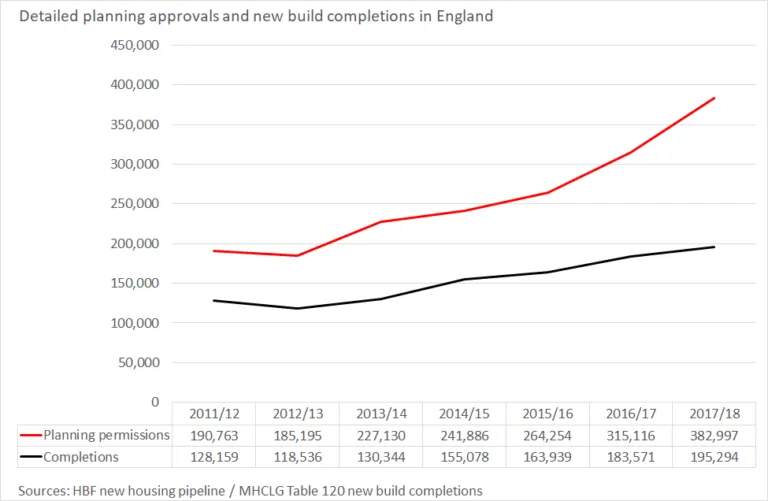More planning permissions but not enough homes
Published: by Eleni Stratton

It’s all change in politics. A new prime minister, fresh faces around the cabinet table and a clear shift in priority and direction for government policy. Despite this some things remain consistent, including the government’s commitment to deliver 300,000 new homes per year by the mid-2020s, most of which will be new build homes.
But we haven’t managed to build more than 200,000 new homes in England for thirty years. We need to build more, and we need to build faster. And currently, one of the ways that is being considered to achieve this is to look again at the planning system.
A focus on planning
For many years, it has been argued by some that the planning system is a major barrier to solving the housing crisis because it’s too slow and complicated in granting planning permissions. But planning departments approved 75% of residential applications in 2018, with the majority processed quickly. Planning permissions granted for new homes have more than doubled over the last six years to 382,997 in 2017/18 – more than enough to meet government targets in coming years.
Given we have twice the number of planning permissions as six years ago, we might expect a similar rise in the number of houses being built. But new build completions have only increased by half as much. And the gap between permissions granted and homes built is growing wider every year.

Of course, we can’t expect homes to materialise immediately upon granting planning permission. Time naturally passes between obtaining planning approval, starting on site, and actually completing the homes.
Balancing a range of evidence on how long it should take for planning permissions to turn into homes from the Local Government Association, Lichfields and developers themselves, two years seems to be a reasonable timeframe. In Shelter’s new analysis on planning permissions and completions published in the Times today, we found 280,000 missing homes from planning permissions granted between 2011/12 – 2015/16, even with two years for building to be completed.
The problem with current build-out rates
This demonstrates a key problem with the current housebuilding model: in order to avoid making a loss, developers will only build homes as fast as they can sell them at current prices. Shelter has pointed to the issues with an over-reliance on this model of housebuilding for years. Sir Oliver Letwin’s 2018 Independent Review of Build Out confirmed that the fundamental driver of build out rates is the ‘absorption rate’ – the rate at which market sale homes can be sold without undermining existing prices in the local market.
Developers need to sell new homes at the highest possible price, because that’s the price they factor in when buying the land to develop in the first place. So rather than flooding the local market by building all at once, they drip-feed completed homes in order to sell at the optimum price and deliver the return on their initial investment.
All this makes perfect sense for developers. For a government pursuing a 300,000 homes per year target, though, it makes no sense at all to rely on this method.
And for those suffering the effects of the housing crisis, building slowly and prioritising homes at eye watering prices will never be the solution. At a time when 1.1 million households are on social housing waiting lists and more and more families are stuck in insecure and often unaffordable private rental properties with no way to save for the future, we need to find a way to build both quickly and affordably.
More planning permissions – while welcome – are simply not going to solve our housing crisis. We need to rethink our current model of housebuilding, starting with the role social housing can play in driving up overall housing supply. The last time England built more than 300,000 homes was in 1969, when councils and housing associations built 47% of new homes.
Unlike market housing, social housing is particularly suitable for rapid build-out, as demand is ‘virtually unlimited’ in many areas. Developments with more than 40% social and affordable housing have a build out rate that is 50% higher compared to developments with less than 10%.
This is one reason why Shelter is campaigning for a new generation of social housebuilding to deliver the homes that communities need.
To do this, we are also calling on the new government to reform the Land Compensation Act 1961 to provide a secure supply of affordable land on which this new generation of social housing can be built.
Join 70,000 other supporters. Ask the new government to build a new generation social housing by signing our petition.